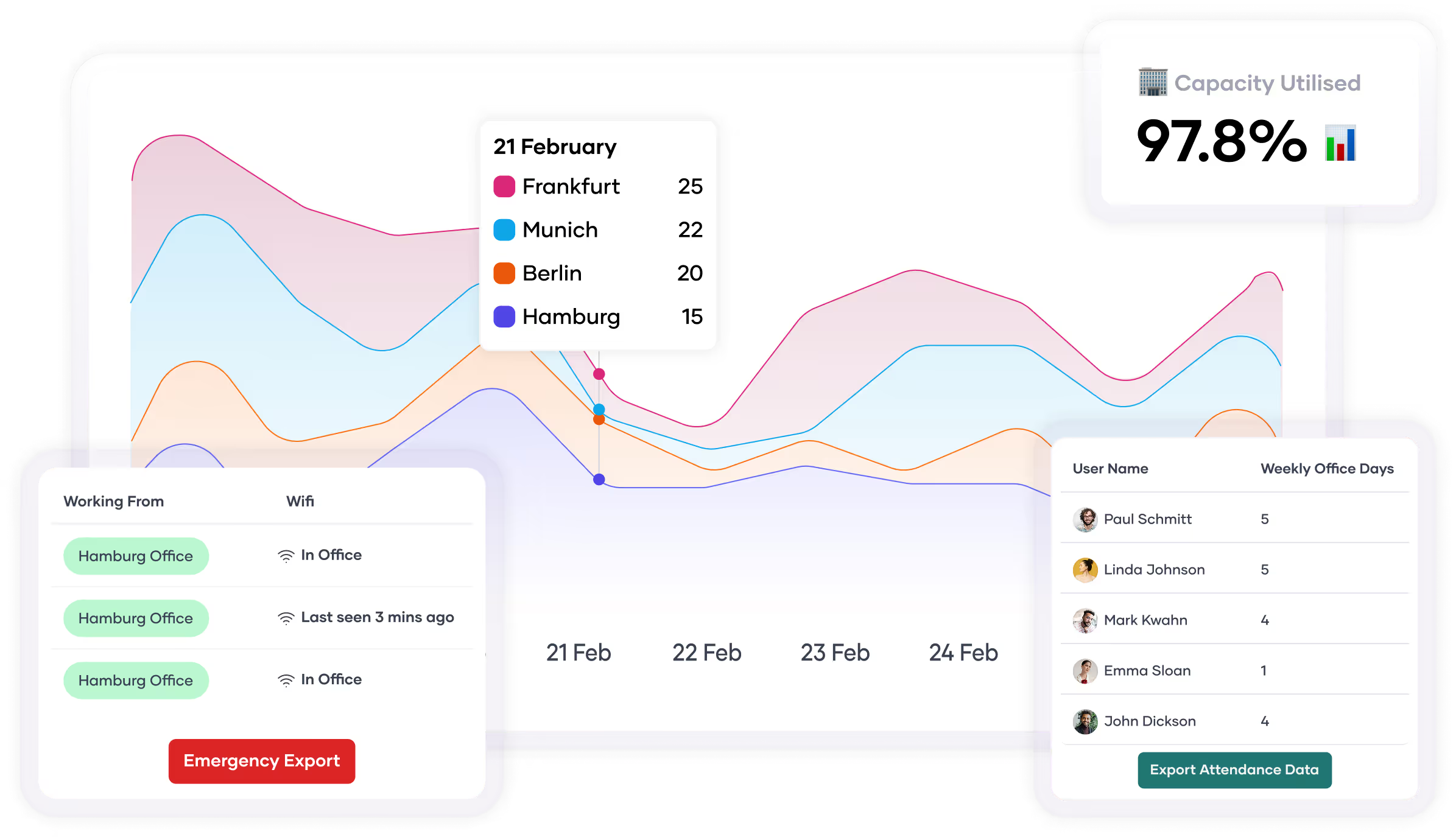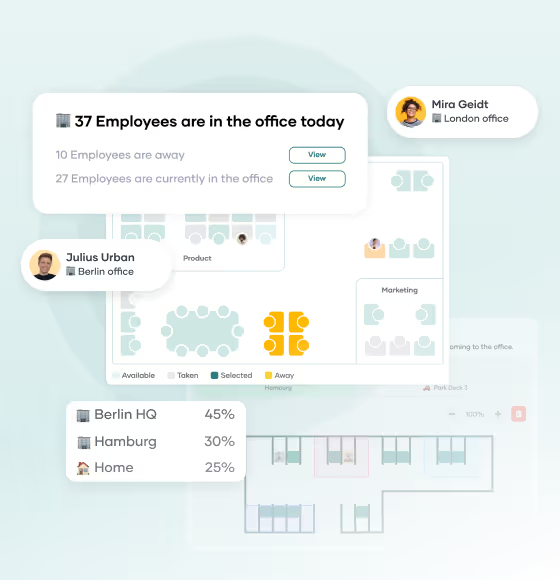Calculate Your Desk Sharing Ratio

Desk Sharing Ratio
You pay thousands of euros in rent every month for office space, yet half the desks sit empty each day while your team complains about too few meeting rooms, missing quiet zones or insufficient collaboration areas. The solution lies in correctly calculating the Desk Sharing Ratio—a simple key figure that shows how to repurpose existing space intelligently. In this article you’ll learn how to calculate the ratio for your industry, which benchmarks other companies use and what insights and measures you can derive.
What Is the Desk Sharing Ratio?
The Desk Sharing Ratio expresses the relationship between available workstations and your total number of employees.
Example: You have 100 employees and 70 desks. Your Desk Sharing Ratio is 0.7.
That means 1.43 employees share each workstation, or put differently: not everyone can be in the office at the same time.
- Desk Sharing Ratio Below 1.0: Fewer desks than employees (true desk sharing)
- Desk Sharing Ratio Exactly 1.0: Traditional model, one desk per employee
- Desk Sharing Ratio Above 1.0: More desks than employees (oversupply—e.g., with coworking or guest desks)
The ratio helps you make three essential decisions: you see whether your current office space is optimally used, you can calculate how much space you really need when expanding or relocating, and you gain an objective basis for discussions with management about space costs.
Difference: Desk Sharing Ratio vs. Utilisation Rate
Do not confuse the Desk Sharing Ratio with the utilisation rate, which measures how often the available desks are actually used. The Desk Sharing Ratio is a planning value; the utilisation rate is a measurement value.
Application of the Desk Sharing Ratio
- Space planning and cost control: With the ratio you calculate exactly how much office space you need when changing buildings. Example: An IT company with 200 employees moves offices and reduces its ratio from 1.0 to 0.7. The new space can therefore be 30 % smaller.
- Repurposing space: Identify unused desks and convert them into meeting rooms, quiet zones or creative areas. Instead of 20 empty desks you could create an extra meeting room and a lounge for your team.
- Growth planning: When your company grows you do not need to rent proportionally more space. With a ratio of 0.8 you can accommodate 25 % more employees without moving.
- Decision basis: The ratio replaces gut feeling with facts—especially helpful in negotiations with management, the works council or during budgeting.
{{hint-box}}
The basic formula gives you a figure that shows the bare facts. For planning office space or restructurings it is extended to show the number of required desks.
{{hint-box-2}}
Step 1: Determine Employee Count
Count all employees who could in principle need a workstation, including full-time and part-time staff, working students and external consultants who regularly work on-site. For interns you can use a lump sum value.
Step 2: Analyse Attendance Patterns
Find out how often your employees are actually in the office. A meaningful survey requires a longer period that balances cyclical differences—mainly weekday effects and monthly rhythm. Ideally, carry it out outside holiday periods and seasonal peaks. In general: the longer the observation period, the more reliable the numbers.
Typical reasons for absence:
- Home office (usually 2–3 days per week)
- Vacation (around 25–30 days per year)
- Sickness (about 15 days per year)
- Business travel and client appointments
- Training and conferences
Example: Your employees are on-site 60 % of the time on average. With 100 employees you theoretically need 60 desks.
Step 3: Add a Safety Buffer
Without a buffer the office can quickly become crowded. We recommend 10–15 % extra desks for:
- Team days or all-hands meetings
- Fluctuations during the year
- Onboarding new employees
Example continued: 100 employees × 60 % = 60 desks. With a 15 % buffer: 60 × 1.15 = 69 desks. Your Desk Sharing Ratio is then 0.69.
Practical Calculation Examples
IT start-up
With 50 employees who are on-site 60 % of the time (≈ three home-office days per week) and a 15 % safety buffer, the company needs 35 desks, giving a Desk Sharing Ratio of 0.70.
Consulting firm
A workforce of 100 employees, an on-site rate of 40 % because of intensive client work and a 10 % buffer means 44 desks are required, resulting in a ratio of 0.44.
Financial services
For 80 employees with an on-site rate of 85 % (little home-office) and a 10 % buffer, 75 desks are needed, which equates to a ratio of 0.94.
Desk Sharing Ratios by Industry
IT & Tech Companies
Recommended ratio: 0.6 – 0.8
Tech firms are pioneers of flexible work. Developers often focus at home but come to the office for sprints and pair programming. A software company with 120 developers manages with a ratio of 0.65; staff are on-site only 2.5 days per week on average.
Financial Services
Recommended ratio: 0.8 – 0.9
Banks and insurers are more cautious. Compliance requirements, confidential customer data and a more traditional culture keep home-office rates lower. Example: A regional bank starts at 0.85 and lowers to 0.78 after one year. Certain workstations require special IT security; customer advisory work is mainly on-site; regulators sometimes require everyone in the office at short notice.
Consulting & Professional Services
Recommended ratio: 0.4 – 0.7
Consultants work mainly at client sites. Example: An international consultancy has 200 consultants but only 90 desks, giving a ratio of 0.45—possible because 70 % of time is spent at clients. There are extreme fluctuations; in holiday season the office can be empty, before proposal deadlines every desk is occupied. Only a booking system ensures that a desk is available after travelling to the office.
Marketing & Creative Agencies
Recommended ratio: 0.6 – 0.8
Creatives need inspiration from others but also like focused solo work. A digital agency with 60 employees runs a ratio of 0.7, providing enough space for spontaneous brainstorming yet flexibility for home-office. Creative rooms and presentation areas are additionally needed; freelancer attendance varies greatly.
Guide: Applying the Desk Sharing Ratio Company-Wide
Phase 1: Analysis and Data Collection
- Count all usable desks and document their equipment (e.g., dual monitors, laptop dock).
- Measure attendance for at least a month using an Excel sheet, time-tracking system or badge data—ensure no individual behaviours can be identified later.
- Survey employees anonymously (5–6 questions) on home-office frequency, client appointments and desk preferences.
Phase 2: Calculate Ratios and Develop Scenarios
Use your data and the formulas. Typical reference scenarios:
- Conservative (0.9): Minimal risk, low savings—good starting point.
- Moderate (0.7): Balanced efficiency and comfort—often ideal.
- Very progressive (0.5): Maximum efficiency, higher risk of too few desks—only for highly flexible models.
For each scenario calculate cost savings if you moved into smaller premises, including rent, utilities, cleaning and IT.
Phase 3: Prepare Change Management
- Inform the works council from the outset; desk sharing is often subject to co-determination.
- Identify supporters in each department and make them change ambassadors.
Phase 4: Run a Pilot
- Start small—choose a receptive department or floor (IT or Marketing).
- Define measurable goals: desk utilisation, employee satisfaction, issues.
- Hold weekly feedback sessions.
- Provide identical equipment at every desk; introduce a booking system if > 20 employees.
Phase 5: Roll-out and Optimisation (8–12 weeks)
- Expand gradually—allocate 2–3 weeks per department.
- Continuously optimise based on data: which desks are never booked, where are bottlenecks, which teams need closer proximity?
- Adjust the ratio after three months—the initial phase often shows you can plan more boldly or conservatively than expected.
Common Mistakes in Handling the Desk Sharing Ratio
The six most frequent mistakes when dealing with the Desk Sharing Ratio are overly aggressive ratios, physical separation of teams, inconsistent IT equipment, lack of communication, static ratios without adjustment, and ignored legal aspects.
Mistake 1: An Overly Aggressive Ratio from the Start
You think: “If 0.7 is good, 0.5 must be even better.” The outcome: employees have to reserve a workstation far in advance to secure one. Trust in desk availability decreases, and fewer people choose to work on-site. This solves the scarcity problem but unnecessarily pushes staff into home office and creates a feeling of not being welcome.
Solution: Start conservatively at 0.8 and reduce gradually. Better to have a little too much space for six months than two weeks of overcrowding.
Mistake 2: Teams Are Physically Torn Apart
Desk sharing does not mean everyone has to sit randomly. If the marketing team is spread over three floors, collaboration suffers.
Solution: Define team areas. Reserve a fixed zone for each department with 70–80 % of the theoretically required desks. Teams can sit together without everyone needing a fixed seat. Also plan regular team days when all members are on-site.
Mistake 3: Insufficient Technical Preparation
If employees arrive at their booked desk and find the wrong equipment, they are understandably frustrated and cannot start working.
Solution: Rigorously standardise equipment. Every workstation needs identical technology: same monitors, keyboards and docking stations. Invest in a robust cloud infrastructure. Employees must be able to access all required systems from any desk.
Mistake 4: Lack of Communication and Change Management
You announce the new system via email and are surprised by the pushback. Employees fear losing their familiar spot, fail to see the benefits or feel bypassed.
Solution: Communicate early, openly and continuously. Explain not just the “what” but especially the “why.” Hold workshops, answer questions, gather feedback.
Mistake 5: Static Ratio without Monitoring
You calculate the ratio once and leave it unchanged for three years. Meanwhile, everyone works more from home, yet you still have too many workstations.
Solution: Review the ratio quarterly. Examine utilisation data, survey employees, analyse booking patterns.
Mistake 6: Neglecting Legal Aspects
You ignore company agreements, forget the works council or overlook workplace regulations. This can bring the entire project to a halt.
Solution: Inform the works council from the outset and involve it in planning. Check existing company agreements for rules on fixed desks. Ensure all ergonomic and safety standards are met—especially those in the workplace ordinance.
Software for Implementing the Desk Sharing Ratio
Desk sharing requires three capabilities: capturing actual attendance, booking desks after introduction and continuous monitoring of booking behaviour. PULT covers all three.
Automatic Attendance Detection for the Planning Phase
PULT Presence logs attendance automatically: as soon as an employee’s smartphone or laptop connects to the corporate Wi-Fi, they are marked present—no manual action, no forgetting. Zero-click works with your existing WLAN infrastructure (HPE Aruba, Cisco, Ubiquiti, etc.). After two to four weeks you know exact utilisation and can calculate your ratio reliably.
Desk Booking without Re-Learning
PULT integrates directly into Slack, Teams and Outlook. Employees book a desk with one click in the tools they already use—no extra app, no new passwords. The booking plan mirrors your office and shows all available desks with features (standing desk, dual monitors, next to a favourite colleague). Filters help find the right spot fast.
Continuous Optimisation of the Desk Sharing Ratio
PULT Analytics displays average utilisation of desks, zones and rooms per day and week, popular and unpopular desks, and booking behaviour by team. With booking and attendance data you always see your ratio. If overcapacity persists you can either
- gradually remove desks and repurpose freed space (quiet zones, gym, etc.), or
- intensify your back-to-office strategy to bring more employees from home office to the office.
{{cta}}

Desk Sharing Ratio – Frequently Asked Questions
How often should the ratio be reviewed?
Review it quarterly based on actual utilisation data. Adjust more often after new home-office rules or rapid growth.
What happens if too many employees come to the office at once?
Plan a safety buffer of 10–15 %. You can also designate zones that can be quickly converted into desks if needed.
Is the ratio calculated differently for part-time employees?
Yes—count part-timers proportionally (a 50 % employee counts as 0.5). For the Desk Sharing Ratio, actual attendance is more important than the contract model.
Can I use different ratios for different departments?
Yes - e.g. IT support or help-desk staff may be in the office more often than sales. Calculate ratios per department and plan corresponding areas in the office.
Is a Desk Sharing Ratio of 0.5 realistic?
A ratio of 0.5 is realistic only for companies with extremely high home-office rates or extensive field service, such as consultancies. For most organisations it is too aggressive.
A new hybrid workplace experience is coming. Start Now. 🎉





















.avif)





